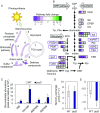JAZ repressors of metabolic defense promote growth and reproductive fitness in Arabidopsis
- PMID: 30348775
- PMCID: PMC6233084
- DOI: 10.1073/pnas.1811828115
JAZ repressors of metabolic defense promote growth and reproductive fitness in Arabidopsis
Abstract
Plant immune responses mediated by the hormone jasmonoyl-l-isoleucine (JA-Ile) are metabolically costly and often linked to reduced growth. Although it is known that JA-Ile activates defense responses by triggering the degradation of JASMONATE ZIM DOMAIN (JAZ) transcriptional repressor proteins, expansion of the JAZ gene family in vascular plants has hampered efforts to understand how this hormone impacts growth and other physiological tasks over the course of ontogeny. Here, we combined mutations within the 13-member Arabidopsis JAZ gene family to investigate the effects of chronic JAZ deficiency on growth, defense, and reproductive output. A higher-order mutant (jaz decuple, jazD) defective in 10 JAZ genes (JAZ1-7, -9, -10, and -13) exhibited robust resistance to insect herbivores and fungal pathogens, which was accompanied by slow vegetative growth and poor reproductive performance. Metabolic phenotypes of jazD discerned from global transcript and protein profiling were indicative of elevated carbon partitioning to amino acid-, protein-, and endoplasmic reticulum body-based defenses controlled by the JA-Ile and ethylene branches of immunity. Resource allocation to a strong defense sink in jazD leaves was associated with increased respiration and hallmarks of carbon starvation but no overt changes in photosynthetic rate. Depletion of the remaining JAZ repressors in jazD further exaggerated growth stunting, nearly abolished seed production and, under extreme conditions, caused spreading necrotic lesions and tissue death. Our results demonstrate that JAZ proteins promote growth and reproductive success at least in part by preventing catastrophic metabolic effects of an unrestrained immune response.
Keywords: carbon starvation; growth–defense trade-off; jasmonate; plant immunity; plant-insect interaction.
Copyright © 2018 the Author(s). Published by PNAS.
Conflict of interest statement
The authors declare no conflict of interest.
Figures





Similar articles
-
Regulation and function of Arabidopsis JASMONATE ZIM-domain genes in response to wounding and herbivory.Plant Physiol. 2008 Mar;146(3):952-64. doi: 10.1104/pp.107.115691. Epub 2008 Jan 25. Plant Physiol. 2008. PMID: 18223147 Free PMC article.
-
CYP94-mediated jasmonoyl-isoleucine hormone oxidation shapes jasmonate profiles and attenuates defence responses to Botrytis cinerea infection.J Exp Bot. 2015 Jul;66(13):3879-92. doi: 10.1093/jxb/erv190. Epub 2015 Apr 22. J Exp Bot. 2015. PMID: 25903915 Free PMC article.
-
A critical role of two positively charged amino acids in the Jas motif of Arabidopsis JAZ proteins in mediating coronatine- and jasmonoyl isoleucine-dependent interactions with the COI1 F-box protein.Plant J. 2008 Sep;55(6):979-88. doi: 10.1111/j.1365-313X.2008.03566.x. Epub 2008 Jun 10. Plant J. 2008. PMID: 18547396 Free PMC article.
-
JAZ repressors and the orchestration of phytohormone crosstalk.Trends Plant Sci. 2012 Jan;17(1):22-31. doi: 10.1016/j.tplants.2011.10.006. Epub 2011 Nov 21. Trends Plant Sci. 2012. PMID: 22112386 Review.
-
Jasmonate passes muster: a receptor and targets for the defense hormone.Annu Rev Plant Biol. 2009;60:183-205. doi: 10.1146/annurev.arplant.043008.092007. Annu Rev Plant Biol. 2009. PMID: 19025383 Review.
Cited by
-
Jasmonates and Plant Salt Stress: Molecular Players, Physiological Effects, and Improving Tolerance by Using Genome-Associated Tools.Int J Mol Sci. 2021 Mar 17;22(6):3082. doi: 10.3390/ijms22063082. Int J Mol Sci. 2021. PMID: 33802953 Free PMC article. Review.
-
The Coordination of Ethylene and Other Hormones in Primary Root Development.Front Plant Sci. 2019 Jul 10;10:874. doi: 10.3389/fpls.2019.00874. eCollection 2019. Front Plant Sci. 2019. PMID: 31354757 Free PMC article. Review.
-
Tomato defences modulate not only insect performance but also their gut microbial composition.Sci Rep. 2023 Oct 24;13(1):18139. doi: 10.1038/s41598-023-44938-2. Sci Rep. 2023. PMID: 37875520 Free PMC article.
-
Mitigating tradeoffs in plant breeding.iScience. 2021 Aug 10;24(9):102965. doi: 10.1016/j.isci.2021.102965. eCollection 2021 Sep 24. iScience. 2021. PMID: 34466788 Free PMC article. Review.
-
Cryo-EM structure and molecular mechanism of the jasmonic acid transporter ABCG16.Nat Plants. 2024 Dec;10(12):2052-2061. doi: 10.1038/s41477-024-01839-0. Epub 2024 Nov 4. Nat Plants. 2024. PMID: 39496849
References
-
- Pieterse CMJ, Leon-Reyes A, Van der Ent S, Van Wees SCM. Networking by small-molecule hormones in plant immunity. Nat Chem Biol. 2009;5:308–316. - PubMed
-
- Santner A, Calderon-Villalobos LIA, Estelle M. Plant hormones are versatile chemical regulators of plant growth. Nat Chem Biol. 2009;5:301–307. - PubMed
-
- Howe GA, Major IT, Koo AJ. Modularity in jasmonate signaling for multistress resilience. Annu Rev Plant Biol. 2018;69:387–415. - PubMed
Publication types
MeSH terms
Substances
Grants and funding
LinkOut - more resources
Full Text Sources
Other Literature Sources
Molecular Biology Databases
Research Materials

